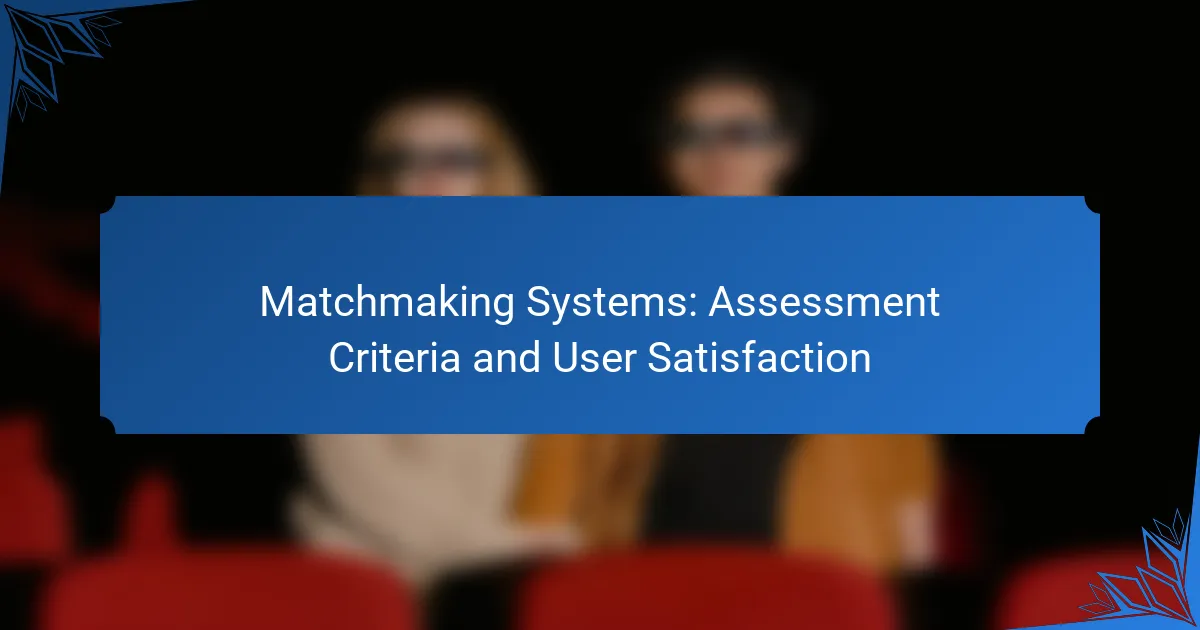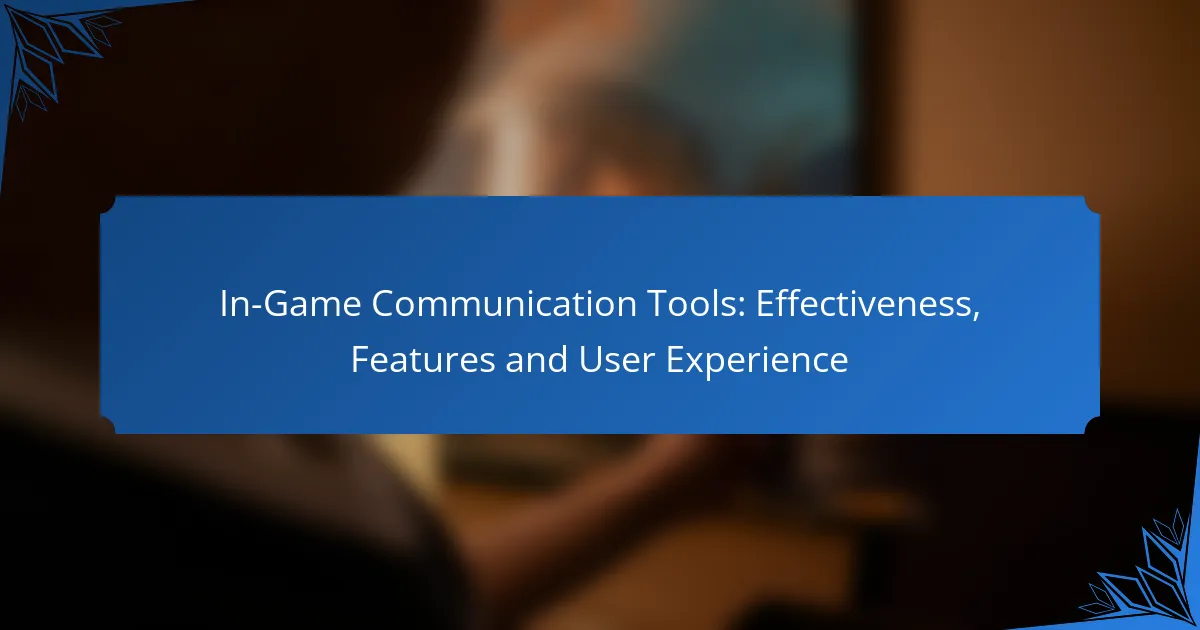Matchmaking systems play a crucial role in connecting individuals by utilizing key assessment criteria such as user compatibility metrics and algorithm transparency. By prioritizing personalized experiences and responsive support, these platforms enhance user satisfaction and foster meaningful connections tailored to individual preferences.

What are the key assessment criteria for matchmaking systems?
Key assessment criteria for matchmaking systems include user compatibility metrics, algorithm transparency, success rates of matches, user feedback mechanisms, and data privacy standards. These factors help users evaluate the effectiveness and reliability of matchmaking services.
User compatibility metrics
User compatibility metrics assess how well potential matches align based on preferences, interests, and values. Common methods include questionnaires and personality tests that generate compatibility scores. A higher score typically indicates a better match, enhancing the likelihood of a successful relationship.
When evaluating compatibility metrics, consider the diversity of factors used. Systems that incorporate a wide range of criteria, such as lifestyle choices, communication styles, and long-term goals, often yield more accurate matches.
Algorithm transparency
Algorithm transparency refers to how clearly a matchmaking system explains its matching process. Users should understand how their data is used and how matches are generated. Systems that provide insights into their algorithms can foster trust and allow users to make informed decisions.
Look for platforms that share details about the factors influencing match outcomes. Transparency can include explanations of weighting systems, data sources, and the rationale behind specific matches, which can enhance user satisfaction.
Success rate of matches
The success rate of matches indicates how often users find meaningful connections through a matchmaking system. This metric can vary widely, with successful platforms reporting rates from 20% to 60% or more, depending on their approach and user engagement.
When assessing success rates, consider the definition of “success” used by the platform. Some may count any interaction as a success, while others focus on long-term relationships or marriages. Understanding these definitions can help users gauge the effectiveness of the service.
User feedback mechanisms
User feedback mechanisms allow participants to share their experiences and rate matches. Effective systems often include surveys, ratings, and testimonials that help improve the matchmaking process. Regular feedback can lead to continuous enhancements in algorithms and user satisfaction.
Choose platforms that actively solicit and respond to user feedback. A responsive system that adapts based on user experiences is likely to provide better matches and foster a more engaged community.
Data privacy standards
Data privacy standards are crucial for protecting users’ personal information within matchmaking systems. Users should look for platforms that comply with regulations such as GDPR in Europe or CCPA in California, ensuring their data is handled securely and responsibly.
When evaluating a service, check for clear privacy policies and data protection measures. Systems that prioritize user privacy often provide options for data control, such as the ability to delete accounts or manage personal information, enhancing user trust and satisfaction.

How do matchmaking systems enhance user satisfaction?
Matchmaking systems enhance user satisfaction by providing tailored experiences that align with individual preferences and needs. By focusing on personalized interactions, responsive support, and community features, these systems create a more engaging and fulfilling environment for users.
Personalized matchmaking experiences
Personalized matchmaking experiences are crucial for user satisfaction as they ensure that users are paired with compatible matches based on their preferences. Systems often utilize algorithms that analyze user data, such as interests, values, and relationship goals, to create tailored suggestions.
For example, a dating app might ask users to complete a detailed questionnaire about their lifestyle and preferences. This information allows the app to suggest matches that share similar interests, increasing the likelihood of successful connections.
Responsive customer support
Responsive customer support plays a vital role in user satisfaction within matchmaking systems. Users often have questions or encounter issues, and timely assistance can significantly enhance their overall experience. Effective support can include live chat, email responses, and comprehensive FAQs.
For instance, if a user faces technical difficulties while using a matchmaking platform, quick access to support can help resolve the issue and prevent frustration. Offering multiple channels for support ensures that users feel valued and heard.
Community engagement features
Community engagement features foster a sense of belonging among users, which can enhance satisfaction. These features may include forums, events, or social media groups where users can interact, share experiences, and build connections beyond individual matches.
For example, a matchmaking service might host local events where users can meet in person, facilitating deeper connections and community building. Such initiatives not only enhance user satisfaction but also encourage long-term engagement with the platform.

What are the most popular matchmaking platforms in the US?
The most popular matchmaking platforms in the US include Match.com, eHarmony, Tinder, and Bumble. Each platform has unique features and caters to different user preferences, making them suitable for various dating goals.
Match.com
Match.com is one of the oldest and most established dating platforms in the US, focusing on serious relationships. Users create detailed profiles and can search for matches based on various criteria, such as interests, values, and location.
To maximize success on Match.com, consider investing time in crafting a comprehensive profile and engaging with potential matches through messages. The platform uses a subscription model, so be aware of the costs associated with premium features.
eHarmony
eHarmony is known for its in-depth personality assessment that helps match users based on compatibility. This platform is ideal for individuals seeking long-term relationships, as it emphasizes meaningful connections over casual dating.
When using eHarmony, complete the personality questionnaire honestly to receive the best matches. The subscription fees can be higher than some competitors, but many users find the investment worthwhile for serious relationships.
Tinder
Tinder revolutionized online dating with its swipe-right-to-like and swipe-left-to-pass functionality. It is primarily used for casual dating and is popular among younger users looking for quick connections.
To effectively use Tinder, maintain an engaging profile with clear photos and a concise bio. Be mindful that while many users seek casual encounters, some do find meaningful relationships on the platform.
Bumble
Bumble distinguishes itself by allowing women to make the first move in heterosexual matches, fostering a more empowered dating environment. It caters to various relationship types, including friendships and professional networking.
On Bumble, ensure your profile reflects your personality and intentions clearly. The app has a time limit for initiating conversations, so be prepared to engage quickly once a match is made.

What factors influence the effectiveness of matchmaking algorithms?
The effectiveness of matchmaking algorithms is primarily influenced by data quality, user behavior analysis, and feedback integration. These factors determine how well the system can accurately match users based on their preferences and behaviors.
Data quality and diversity
High-quality and diverse data is crucial for effective matchmaking. Algorithms rely on accurate user profiles, preferences, and interaction histories to generate meaningful matches. If the data is biased or lacks variety, the algorithm’s output may not reflect the true compatibility between users.
To enhance data quality, platforms should encourage users to provide comprehensive and honest information. This can include demographic details, interests, and relationship goals. A diverse dataset helps the algorithm learn from a wider range of user experiences, improving match accuracy.
User behavior analysis
Understanding user behavior is essential for refining matchmaking algorithms. By analyzing how users interact with the platform—such as their messaging patterns, profile views, and match preferences—algorithms can adapt to better serve individual needs. This analysis can reveal trends that inform future matches.
Platforms should implement tracking mechanisms to gather insights on user engagement. For example, noting which profiles users spend the most time on can help the algorithm prioritize similar matches. Regularly updating user behavior data ensures the algorithm remains relevant and effective.
Feedback integration
Incorporating user feedback is vital for continuous improvement of matchmaking systems. Feedback can come from direct user ratings of matches or through surveys assessing user satisfaction. This information helps identify areas for enhancement in the matching process.
To effectively integrate feedback, platforms should establish a straightforward method for users to share their experiences. Regularly reviewing and acting on this feedback allows algorithms to evolve and better meet user expectations, fostering higher satisfaction rates.

What are the emerging trends in matchmaking systems?
Emerging trends in matchmaking systems focus on personalization, artificial intelligence, and user-centric design. These advancements aim to enhance user satisfaction by providing more accurate matches and improving the overall experience.
Increased use of artificial intelligence
Artificial intelligence (AI) is becoming a cornerstone of modern matchmaking systems. AI algorithms analyze user data to identify patterns and preferences, leading to more precise matches. For instance, platforms may use machine learning to adapt to user behavior over time, refining suggestions based on past interactions.
As AI continues to evolve, it can also facilitate real-time feedback, allowing users to adjust their preferences dynamically. This responsiveness can significantly enhance user satisfaction, as individuals feel more in control of their matchmaking experience.
Focus on user experience and interface design
User experience (UX) and interface design are critical in matchmaking systems. A well-designed interface can simplify navigation and make the matching process more enjoyable. Features such as intuitive layouts, engaging visuals, and easy-to-use filters contribute to a positive user experience.
Moreover, incorporating user feedback into design updates helps platforms stay relevant and responsive to user needs. This iterative approach ensures that the system evolves alongside user expectations, fostering loyalty and satisfaction.
Emphasis on privacy and data security
With growing concerns about data privacy, matchmaking systems are prioritizing user security. Implementing robust encryption methods and transparent data usage policies is essential for building trust. Users are increasingly aware of how their information is handled, and platforms that prioritize privacy are more likely to attract and retain users.
Additionally, regulations such as the General Data Protection Regulation (GDPR) in Europe set strict guidelines for data handling. Compliance with such regulations not only protects users but also enhances the platform’s credibility in a competitive market.



